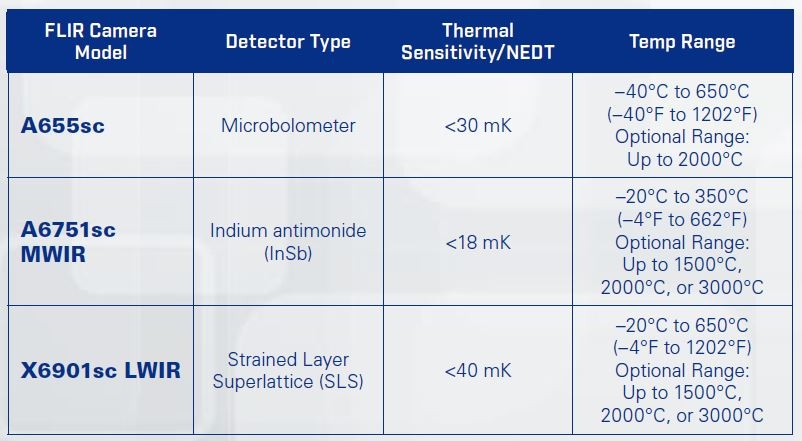Part 1: What temperatures are you expecting to measure?
- 11 Dec 2020
7 Things To Know When Selecting An IR Camera For Research & Development
Introduction
In simple terms, an infrared camera, or “thermal imager” converts infrared radiation into a visual image that depicts temperature variations across an object or scene. This allows one to make non-contact measurements of an object’s temperature for data acquisition, analysis, and reporting. The process of using an IR camera for data viewing, recording, analysis, and reporting is called “thermography.”
Thermography has become an indispensable tool for all kinds of R&D projects. There are a lot of IR camera options available with different features at varying costs, making it difficult to select a camera best-suited to your application. To ensure you choose one that meets all your requirements, SJ Electronics and FLIR UK has put together a list of the seven things you need to know when selecting an IR camera. This list will help you narrow down your options and point you in the right direction for your ultimate camera selection.
Part 1: What temperatures are you expecting to measure?
Typically, the goal of using an IR camera is to measure temperature changes on your object of interest. Two things you should take into consideration when measuring temperature are: the temperature range of your object and the temperature resolution you wish to achieve. Answering these two questions will help you narrow down which types of infrared cameras and detectors are best suited for your application.
Temperature Range
Temperature range is defined by how cold and hot your object will become. This could also be the coldest and hottest temperature in the scene you are viewing. For example, you may be imaging an aircraft engine idling on the runway. In this example, the body of the aircraft may be at an approximate temperature of 25°C and the engine at 500°C. The temperature range would be roughly 25°C to 500°C, so you would look for an IR camera that is capable of measuring the entire range at one time.
Temperature Resolution
Temperature resolution is the smallest temperature difference you need to measure and is commonly referred to as temperature sensitivity. IR camera sensitivities can range from 0.020°C up to 0.075°C, depending on the camera’s detector type.
Temperature resolution or sensitivity for IR cameras is commonly expressed as Noise Equivalent Delta Temperature (NEDT). This figure of merit is the smallest temperature change the IR camera can detect above its noise floor. Simply put, this is the smallest temperature change you can measure with that specific camera. Table 1 shows some common temperature ranges and temperature resolutions of different IR camera types. As you can see there are a lot of options, but defining your temperature range and resolution will help initially narrow down which camera solutions will meet your application requirements.
Note: Temperature resolution (sensitivity) is not the same as the temperature accuracy of the IR camera. Rather, temperature accuracy is the ability of the camera to accurately measure an object’s exact temperature. To help explain, imagine we were looking at a hot mug of coffee that is 90°C, but then it quickly cools off to 89°C. It wouldn’t be difficult for a camera with good sensitivity to detect that subtle temperature change. But if the camera is miscalibrated, it may read the starting temperature as 91°C and the ending temperature as 90°C; therefore, the camera accuracy is roughly ±1°C.
Table 1: Temperature range and resolution of common IR cameras




